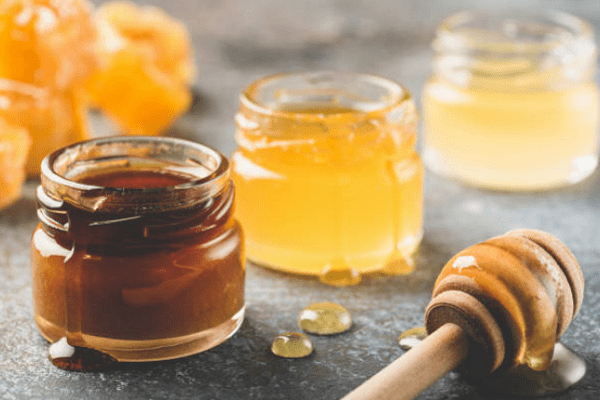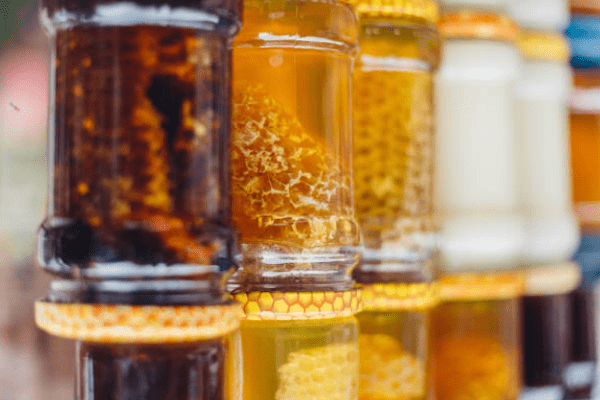Healthy food >>>> How to determine the quality of honey?
How to determine the quality of honey?

The value of Honey is determined by its quality, since Natural Honey is considered a high-quality product with healing properties. How to determine the quality of honey in order to use honey in nutrition as a reliable means for healing or preventing diseases?
Honey is a product of fermentation of pollen and sap of plant flowers by a honey bee (Apis Millifera L.). From the point of view of bee fermentation of plant nectar, Honey is a unique product. But the bee can ferment not only plant nectar, juice and so-called “honeydew” (juice processed by other insects), but also sugar crystals, sugar syrup, as well as aqueous solutions of fructose and artificial sweeteners. A product obtained by bee fermentation of substances such as sugar and its derivatives, artificially created solutions of fructose and solutions with artificial sweeteners is not high-quality honey, despite external resemblance and similar taste. This is falsified honey.
With the development of the chemical industry, it became possible to produce a product called “Honey” based on synthesized compounds. This product is called "Artificial Honey". It looks very similar to Natural honey, and has an almost indistinguishable taste of Natural honey. The opportunity to create Artificial honey appeared when the composition of Natural honey was determined chemically. It turned out that Natural honey, obtained from collecting nectar from flowers and juice of different plants, has a different chemical composition, initially determined by the chemical composition of those plants from which bees collect nectar and juice.
It is known that in different climatic zones honey bees can ferment various types of plant materials. For example, in temperate zones, pollen, sap and honeydew will serve as raw materials for bees. In areas with a tropical climate, where some plants have the ability to secrete juice from leaves and stems, and not only grow juicy fruits, bees collect nectar from such types of juice, ferment it and create Natural honey. Naturally, the chemical composition of these types of honey, created by bees in temperate and tropical climates, will differ in chemical composition, and ultimately in taste and smell.

Natural honey is generalized under the names “Flower honey” and “Honeydew honey”. Natural honey comes in different shades of color: colorless, light yellow, yellow with a lemon tint, yellow with a dark tint, orange-yellow, golden, yellow-brown, reddish, brown with a green tint, light brown, brown to black and black. The color of honey is influenced by the coloring substances found in the nectar collected by the bees. The lightest Flower Honey is obtained from the nectar of Acacia flowers; it has a palette of shades of cream color. Honeydew honey can be colorless or light with shades of green. Honey collected from Tobacco flowers is dark brown in color. Honey collected from Buckwheat has a rich brown color. Honey collected from Pea or Bean flowers has a reddish color. And honey collected from the flowers of deciduous trees is yellow.
Natural honey collected by bees in early spring differs in color from natural honey collected in summer or autumn in that it has brighter shades of yellow, orange or brown.
In addition, the color of Natural honey is influenced by the quality of the container in which it is stored. Honey stored in copper containers takes on a bluish or greenish tint. Honey stored in iron containers takes on a reddish tint. Honey stored in a glass container darkens over time, while honey in which the crystallization process has begun begins to lighten.
It is Flower honey that has the aroma. Honeydew honey has no aroma. But if honey is stored improperly, it loses the aroma that was given to it by organic volatile compounds collected by bees from plant nectar. By the aroma you can determine the place where honey was collected, but only at the stage of its direct collection, but not some time after storage.
From these data it follows that neither the color nor the smell of honey can be criteria for assessing its naturalness or origin.
But if we talk about the taste of honey, then based on the taste of honey, we can assume its naturalness or artificiality. Honey, unlike other natural sweets, has a very specific taste. Natural honey, despite the initial sensation of cloying, has moderate sweetness and slight sourness. Some types of honey have a bitter taste due to the collection of nectar from Tobacco, Chestnut, Willow and other plants. The sweetness of natural honey comes from the high percentage of fructose in its composition. The sweetest Natural honey is Flower honey. But falsified honey is often found, which has insufficient sweetness due to feeding bees with sugar and its derivatives, natural juices (grape, watermelon), starchy substances, and synthetic glucose. And feeding bees with saccharin or dulcine gives honey an overly sweet, cloying taste.
In high-quality Natural honey the chemical composition is determined by the amount of sucrose (about 5% in Flower honey, about 10% in Honeydew honey). The natural ability of bees to ferment nectar into honey is ensured by the production of a certain amount of enzymes for these purposes, determined by nature. But if bees are fed, then they do not have enough enzymes to ferment sugars, and the percentage of sucrose in the chemical composition of honey increases to 25%, which serves as evidence of falsification of honey.
To increase the accuracy of determining the quality of honey it is worth keeping in mind that when storing honey in a dark place (as is usually done), the percentage of sucrose gradually decreases as bee enzymes continue their action. But if the honey is exposed to sunlight, which destroys the enzymes, the percentage of sucrose may remain at its original level. Thus, it is possible to determine the quality of honey storage conditions.
Another criterion can be used to determine the quality of honey - this is the degree of its acidity. For obvious reasons, the composition of natural honey includes almost all fruit acids (malic, citric and others), as well as tartaric, oxalic and lactic acids. It is their content that gives honey a slight sourness. But the total amount of these acids is within 3-4%. When honey is falsification, this acidity level becomes either higher or lower (sometimes even an alkaline environment is determined). When honey turns sour due to improper storage, the acidity of honey also increases.
You need to know that the quality of honey greatly influences its medicinal properties. When the highest quality honey is heated to more than 140 degrees Fahrenheit (60 degrees Celsius) or when it is stored for a long time in the sun, enzymes, essential oils and antimicrobial substances are destroyed, and the acidity of the honey increases. In this case, honey turns into a regular mixture of sugars with different flavors.

Read

Read



























